Aerospace Warranty Trends:
Unlike the computer and passenger car industries, in the commercial aviation industry the customer-facing brand names and their suppliers share warranty costs much more equitably. Then again, these multi-million-dollar jets and helicopters are hardly consumer products. And since safety and reliability are such top priorities, consistently low warranty costs are to be expected.
One could be forgiven for not being able to find much evidence of a recession in the aerospace industry. Of the top 20 U.S.-based manufacturers in the sector, only three saw sales declines in their civilian aerospace business last year, and only Boeing saw more than a 10% decline. Among the 75 U.S.-based companies in the business, only 17 saw sales declines of 10% or more last year. Twenty-five saw sales gains greater than 10%.
It's been a while since Warranty Week examined the aerospace sector, and with six years of warranty data now available, we thought it a good time to take a closer look. So we added together the quarterly claims reported by the 75 companies over the past 24 quarters, and Figure 1 is the result.
Figure 1
U.S.-based Aerospace Manufacturers
Warranty Claims Paid per Quarter, 2003-2008
(in US$ millions)

There does seem to be a bit of a peak in the data in Figure 1, with claims reaching the $475 million level in the first quarter of 2008, then declining. But at $417 million, the most recent quarter was only $31 million below year-ago levels. And as can be seen in Figure 2 below, claims for the entire year were up substantially from 2007 levels. The last year in which claims fell was 2005.
We should note that for this analysis, we included not only the traditional mainstream aerospace companies such as Boeing, Goodrich and Rockwell Collins, but also some companies that split their activities into multiple industries. Some are also major warranty providers in the automotive, consumer electronics and/or appliance industries. So because companies report only their enterprise-wide totals, we're also including the automotive warranties of Honeywell, the consumer warranties of Garmin, and the air conditioning warranties of United Technologies' Carrier unit in Figures 1 to 3 alongside their aerospace warranty expenses.
That means some of the totals and averages are a little different than before, because this time more non-aerospace products are included. If there were a reliable way to separate the warranty expenses by product line or by division, we'd do it. But without inside information, all we'd be doing is guessing.
Aircraft & Air Conditioners?
Including United Technologies produces the biggest change in the totals and averages. We suspect that more than half their total warranty expenses arise from air conditioners and elevators. And that total is a big number: the company reported $551 million in warranty claims last year and $531 million in 2007. But 40% of their revenue and more than half of their profits comes from the aerospace operations of Pratt & Whitney, Hamilton Sundstrand, Sikorsky, and other aerospace units. So they're just as at home in the aerospace sector.
We've split the list of 75 companies into separate groupings of airframe makers and their suppliers. And even here, the placement of United Technologies has an effect on the outcome. Sikorsky makes helicopters, but Pratt & Whitney makes jet engines and Hamilton Sundstrand makes avionics. So United Technologies could be counted as either an OEM or a supplier.
The term OEM isn't really used to connote the makers of airplanes and helicopters, but in Figures 2 and 3 we want to make an analogy to the computer and automotive industries, where the term is used frequently. In the aerospace industry, our OEMs are Boeing, Textron, General Dynamics, plus internationally-based manufacturers such as Airbus and Embraer. They're analogous to General Motors, Ford, and Chrysler, plus internationally-based OEMs such as Toyota and Honda. And in the computer industry, their peers would be Hewlett-Packard, Dell, and Apple, plus internationally-based firms such as Sony and Acer.
The point we want to make is that in the aerospace industry, the OEMs don't end up paying the bulk of the warranty claims, as is the case for automotive and computer makers. In fact, as Figure 2 shows, the suppliers actually pay well over half the claims, although that of course depends heavily on the classification of United Technologies as an aerospace supplier rather than as an OEM.
Figure 2
Aerospace Warranty Claims
Worldwide Warranty Claims of U.S.-based Companies, 2003-2008
(claims paid in US$ millions)

In 2008, the aerospace industry total for claims paid was $1.766 billion, up 7.3% from 2007 levels. Suppliers saw 7.5% growth while the airframe makers saw a 6.9% rise in claims paid. Sales were up by only 2.3% overall, so the industry claims rate actually grew from 0.91% at the end of 2007 to 0.95% at the end of 2008.
OEMs and Suppliers the Same?
In the October 2, 2007 and July 24, 2008 newsletters, we found that the airframe makers paid roughly the same percentage of revenue for warranty claims as did their suppliers. As can be seen in Figure 3, that trend seems to have continued up to the present day.
Figure 3
U.S.-based Aerospace Warranty Providers
Average Claims Rates of Airframe Makers
and Their Suppliers, 2003-2008
(claims as a percentage of product sales)

The difference between the claims rates of aerospace OEMs and their suppliers has never been more than half a percentage point, and has averaged closer to 0.2% over the past six years. Compare that to an almost constant 2% gap found in the automotive industry between OEMs and their suppliers, and you could make a case that the airframe makers are much better at pushing warranty costs back onto their suppliers than are the land vehicle makers.
However, warranties aren't structured the same way in the aerospace industry as they are for passenger car makers, who normally pay the dealer first and then try to recover the cost from their suppliers. In fact, in commercial aviation they're structured much like they are in the trucking industry, where the engine, chassis, and other major components have their own separate warranties that are issued to the buyer separately. There is no "nose-to-tail" warranty. The jet engines, avionics, and interiors are all manufactured, purchased, and warranted separately. There's also an increased amount of paperwork that makes it easier to keep the claims separate.
Commercial Airframe Makers
Boeing and Airbus continue to trade the lead in commercial aviation revenue worldwide, but since Airbus is based in Europe and does not report its warranty expenses externally, the largest airframe maker included in this week's tallies is Boeing. Commercial airplane revenue fell 15% last year to $28.3 billion, but defense revenue fell only $5 million. Warranty claims actually grew, from $220 million in 2007 to $253 million in 2008.
In Figure 4 below, one can see the effects of that revenue decline and claims rise in the form of an increase in the company's claims rate. As a percentage of commercial revenue, Boeing's claims rate grew from 0.7% at the end of 2007 to 0.9% at the end of 2008. It was the highest level for the company's claims rate since 2004.
Figure 4
Boeing Co.
Warranty Claims & Accrual Rates, 2003-2008
(as a percentage of product sales)
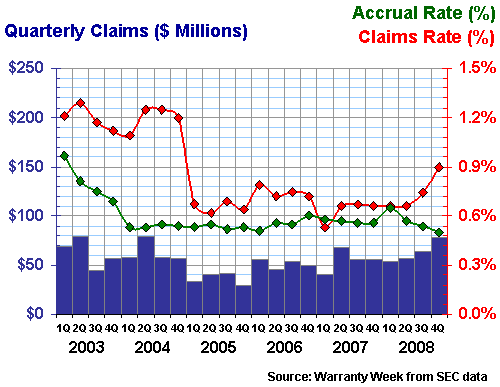
The accrual rate, meanwhile, fell to its lowest point of the last six years. Since accruals reflect what a company believes its warranties will cost in the future, Boeing must be predicting improved quality for the near future. How else to explain a cut in accruals from $186 million in 2007 to $140 million in 2008?
Our next aviation company is actually also a diverse conglomerate along the lines of United Technologies. Textron owns Cessna and Bell Helicopter, which makes it an airframe maker, but it also owns Kautex (automotive fuel systems), E-Z-Go (golf carts), Jacobsen (lawn care), and Greenlee (telecom tools). And it's a major defense contractor. But since 60% of its revenues come from commercial airframes, there's no doubt it's on the right list here.
Takeover Rumors
This week, Textron has been swept up in a swirl of intense and as-yet unconfirmed takeover rumors, which first mentioned Lockheed Martin and then whispered some vague Kuwait/Emirates consortium as the buyer. Perhaps it's both, because the sale of Textron's defense business to a Middle Eastern buyer would never pass muster at the Pentagon. Perhaps multiple buyers will each acquire a piece of the company?
In Figure 5 below, the quarterly data for 2003, 2004 and 2005 is estimated based on annual reports, because at the time Textron provided only annual warranty figures. But then in 2006, Textron began reporting its warranty expenses quarterly. Whichever way you look at it, there's not a whole lot of variability in the data. Claims and accruals have always remained close to 1.5%, though accruals were a bit above that rate back in 2005 and 2006. And, more importantly, claims and accrual rates have been very close to each other for the past two years.
Figure 5
Textron Inc.
Warranty Claims & Accrual Rates, 2003-2008
(as a percentage of product sales)
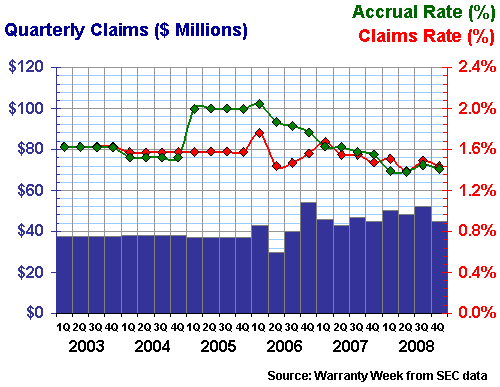
Textron reported $195 million in warranty claims last year, up $14 million from 2007 levels. Accruals actually fell slightly, from $191 million in 2007 to $190 million in 2008. But because product sales were up 9% for the year, the claims and accrual rates both went down to around 1.4% by the end of 2008. The warranty reserve, meanwhile, has shrank by $41 million to $280 million by the end of 2008.
Gulfstream Aerospace
Besides Cessna, the other big name in general aviation is Gulfstream Aerospace, a unit of General Dynamics that began half a century ago as an offshoot of Grumman. Gulfstream now accounts for around a fifth of its parent company's revenue, the rest being primarily defense work. That civilian aviation business was actually up by 14% last year, to $5.5 billion. Meanwhile, both claims and accruals fell, which translated into big declines for the claims and accrual rates.
As Figure 6 below shows, General Dynamics' claims rate fell from 1.3% at the end of 2007 to 0.9% at the end of 2008, while its accrual rate fell from 1.6% to 1.3%. Both rates are now at the good end of a multi-year downward trend. And they're well below the rates the company saw in 2003, when various new product introductions caused an upturn in warranty costs.
Figure 6
General Dynamics Corp.
Warranty Claims & Accrual Rates, 2003-2008
(as a percentage of product sales)

It's not all that different for the aerospace suppliers, although the three we've selected for snapshots this week have shown a bit more volatility than the typical airframe maker. In Figure 7 below, Goodrich Corp. is seen to have experienced a claims rate falling as low as 0.3% and rising as high as 1.4% over the past six years.
Figure 7
Goodrich Corp.
Warranty Claims & Accrual Rates, 2003-2008
(as a percentage of product sales)
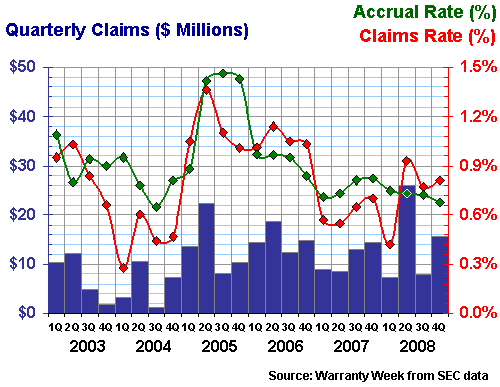
Goodrich is firmly in the supplier column, selling landing gear, wheels, brakes, and fuel systems to airframe makers. Named after its founder Benjamin Franklin Goodrich, the B.F. Goodrich Company exited the automotive tire business 20 years ago to concentrate on the aviation industry. Sales to Boeing now comprise 14% of total revenue while sales to Airbus comprise another 15% of revenue. Defense work is only 13% of the company's activity, significantly less a proportion of total revenue than is the case at General Dynamics, Textron, or Boeing.
Moog Inc. competes with Goodrich in areas such as flight control actuation systems. It was started in 1951 as a supplier of aircraft and missile components such as the electro-hydraulic servo valve, used on fighter aircraft and guided missiles during the Cold War. The company's founders, brothers William C. Moog and Arthur Moog, were cousins of Robert A. Moog, inventor of the electronic synthesizer that bears his name.
Moog Inc. saw a very slight decline in its revenue during the fourth quarter of 2008, but saw much larger increases in both its claims and accrual rates. Claims jumped from $1.1 million in the fourth quarter of 2007 to $1.6 million in the fourth quarter of 2008, and the claims rate rose from 0.24 to 0.35%. Accruals grew from $1.8 million to $2.6 million, and the accrual rate grew from 0.4% to 0.6%.
Then again, as Figure 8 illustrates, Moog's warranty costs have never been a very large percentage of the company's total revenue. Its highest accrual rate during the past six years was 0.66% while its highest claims rate was 0.53%. These rates are both below average, as a quick comparison with Figure 3 would confirm.
Figure 8
Moog Inc.
Warranty Claims & Accrual Rates, 2003-2008
(as a percentage of product sales)
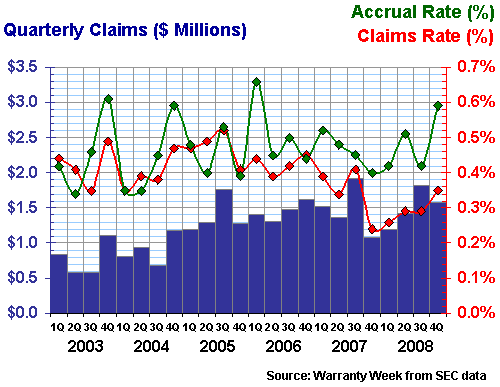
B/E Aerospace is a major supplier of airplane seating, lighting, and food preparation equipment. It also has a significant stake in the sale of consumables, which we have subtracted out of the calculations that determine claims and accrual rates. Still, the effect of some recent acquisitions can be seen in Figure 9, in which both claims and accruals have risen significantly during the past year and a half.
Growth Through Acquisitions
The company's name reflects its history of growth through acquisitions. In 1989, Bach Engineering acquired EECO Avionics, and combined the two under the B/E banner. It has since made 25 more acquisitions, including one last year and two in 2006.
Figure 9
B/E Aerospace Inc.
Warranty Claims & Accrual Rates, 2003-2008
(as a percentage of product sales)
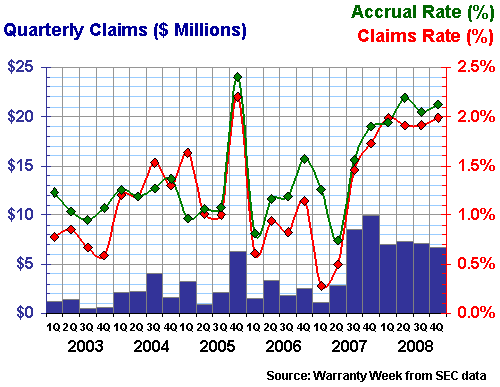
Warranted product sales were up 9% last year, which helped the company cover part of the increase in claims and accruals. Claims grew from $22 million to $28 million, and the claims rate rose from 1.7% to 2.0%. Accruals jumped 20% to $30 million, but the accrual rate rose only a bit, from 1.9% to 2.1%. Still, both are up significantly from the levels seen in the first half of 2007, when claims were as low as 0.3% and accruals were as low as 0.7% of product revenue.
Go to Part One
Go to Part Two
Go to Part Three
Go to Part Four
This is Part Five
Go to Part Six
Go to Part Seven
Go to Part Eight
Go to Part Nine









